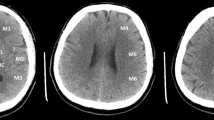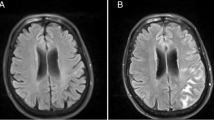Abstract
Objectives
The hyperintense acute reperfusion marker (HARM) has been described as a predictor for haemorrhagic transformation (HT) in acute ischaemic stroke. We hypothesised that this phenomenon is not present in the elderly.
Methods
It was possible to assess 47/84 consecutive patients aged 80 and over with diagnosed ischaemic stroke or transient ischaemic attack (TIA). MRI was performed within 24 h of onset of symptoms with follow-up MRI within a further 48 h.
Results
Of 47 included patients, 19 showed HARM; it was only seen on follow-up examination. Ten of the 47 patients underwent thrombolysis with recombinant tissue plasminogen activator (rt-PA); 4 of them showed HARM, and 1 of those showed HT. HARM was found in three out of eight patients with haemorrhagic transformation on baseline and/or follow-up MRI. We did not observe an association between HARM and early HT either in the whole group or in the patients who received thrombolysis.
Conclusion
HARM was not associated with HT in the elderly after ischaemic stroke, independent of treatment. While it may indicate dysfunction of the blood-brain barrier (BBB), it does not necessarily amount to HT.


Similar content being viewed by others
References
Kolominsky-Rabas PL, Sarti C, Heuschmann PU, Graf C, Siemonsen S, Neundoerfer B, Katalinic A, Lang E, Gassmann KG, von Stockert TR (1998) A prospective community-based study of stroke in Germany–the Erlangen Stroke Project (ESPro): incidence and case fatality at 1, 3, and 12 months. Stroke 29:2501–2506
Bamford J, Sandercock P, Dennis M, Burn J, Warlow C (1990) A prospective study of acute cerebrovascular disease in the community: the Oxfordshire Community Stroke Project–1981–86. 2. Incidence, case fatality rates and overall outcome at 1 year of cerebral infarction, primary intracerebral and subarachnoid haemorrhage. J Neurol Neurosurg Psychiatry 53:16–22. doi:10.1136/jnnp.53.1.16
Kammersgaard LP, Jorgensen HS, Reith J, Nakayama H, Pedersen PM, Olsen TS (2004) Short- and long-term prognosis for very old stroke patients. The Copenhagen Stroke Study. Age Ageing 33:149–154. doi:10.1093/ageing/afh052
Murray CJ, Lopez AD (1997) Alternative projections of mortality and disability by cause 1990-2020: Global Burden of Disease Study. Lancet 349:1498–1504. doi:10.1016/S0140-6736(96)07492-2
Khatri P, Wechsler LR, Broderick JP (2007) Intracranial hemorrhage associated with revascularization therapies. Stroke 38:431–440. doi:10.1161/01.STR.0000254524.23708.c9
Larrue V, von Kummer RR, Muller A, Bluhmki (2001) Risk factors for severe hemorrhagic transformation in ischemic stroke patients treated with recombinant tissue plasminogen activator: a secondary analysis of the European-Australasian Acute Stroke Study (ECASS II). Stroke 32:438–441
Molina CA, Alvarez-Sabin J, Montaner J, Abilleira S, Arenillas JF, Coscojuela P, Romero F, Codina A (2002) Thrombolysis-related hemorrhagic infarction: a marker of early reperfusion, reduced infarct size, and improved outcome in patients with proximal middle cerebral artery occlusion. Stroke 33:1551–1556. doi:10.1161/01.STR.0000016323.13456.E5
Toni D, Fiorelli M, Bastianello S, Sacchetti ML, Sette G, Argentino C, Montinaro E, Bozzao L (1996) Hemorrhagic transformation of brain infarct: predictability in the first 5 h from stroke onset and influence on clinical outcome. Neurology 46:341–345
Berger C, Fiorelli M, Steiner T, Schabitz WR, Bozzao L, Bluhmki E, Hacke W, von Kummer R (2001) Hemorrhagic transformation of ischemic brain tissue: asymptomatic or symptomatic? Stroke 32:1330–1335
Fiorelli M, Bastianello S, von Kummer R, del Zoppo GJ, Larrue V, Lesaffre E, Ringleb AP, Lorenzano S, Manelfe C, Bozzao L (1999) Hemorrhagic transformation within 36 h of a cerebral infarct: relationships with early clinical deterioration and 3-month outcome in the European Cooperative Acute Stroke Study I (ECASS I) cohort. Stroke 30:2280–2284
Hacke W, Kaste M, Fieschi C, Toni D, Lesaffre E, von Kummer R, Boysen G, Bluhmki E, Hoxter G, Mahagne MH et al (1995) Intravenous thrombolysis with recombinant tissue plasminogen activator for acute hemispheric stroke. The European Cooperative Acute Stroke Study (ECASS). JAMA 274:1017–1025
Lansberg MG, Thijs VN, Bammer R, Kemp S, Wijman CA, Marks MP, Albers GW (2007) Risk factors of symptomatic intracerebral hemorrhage after tPA therapy for acute stroke. Stroke 38:2275–2278. doi:10.1161/STROKEAHA.106.480475
Dijkhuizen RM, Asahi M, Wu O, Rosen BR, Lo EH (2002) Rapid breakdown of microvascular barriers and subsequent hemorrhagic transformation after delayed recombinant tissue plasminogen activator treatment in a rat embolic stroke model. Stroke 33:2100–2104. doi:10.1161/01.STR.0000023534.37670.F7
Neumann-Haefelin C, Brinker G, Uhlenkuken U, Pillekamp F, Hossmann KA, Hoehn M (2002) Prediction of hemorrhagic transformation after thrombolytic therapy of clot embolism: an MRI investigation in rat brain. Stroke 33:1392–1398. doi:10.1161/01.STR.0000014619.59851.65
Bang OY, Buck BH, Saver JL, Alger JR, Yoon SR, Starkman S, Ovbiagele B, Kim D, Ali LK, Sanossian N, Jahan R, Duckwiler GR, Vinuela F, Salamon N, Villablanca JP, Liebeskind DS (2007) Prediction of hemorrhagic transformation after recanalization therapy using T2*-permeability magnetic resonance imaging. Ann Neurol 62:170–176. doi:10.1002/ana.21174
Hjort N, Wu O, Ashkanian M, Solling C, Mouridsen K, Christensen S, Gyldensted C, Andersen G, Ostergaard L (2008) MRI detection of early blood-brain barrier disruption: parenchymal enhancement predicts focal hemorrhagic transformation after thrombolysis. Stroke 39:1025–1028. doi:10.1161/STROKEAHA.107.497719
Kassner A, Roberts T, Taylor K, Silver F, Mikulis D (2005) Prediction of hemorrhage in acute ischemic stroke using permeability MR imaging. AJNR Am J Neuroradiol 26:2213–2217
Kastrup A, Groschel K, Ringer TM, Redecker C, Cordesmeyer R, Witte OW, Terborg C (2008) Early disruption of the blood-brain barrier after thrombolytic therapy predicts hemorrhage in patients with acute stroke. Stroke 39:2385–2387. doi:10.1161/STROKEAHA.107.505420
Kim EY, Na DG, Kim SS, Lee KH, Ryoo JW, Kim HK (2005) Prediction of hemorrhagic transformation in acute ischemic stroke: role of diffusion-weighted imaging and early parenchymal enhancement. AJNR Am J Neuroradiol 26:1050–1055
Latour LL, Kang DW, Ezzeddine MA, Chalela JA, Warach S (2004) Early blood-brain barrier disruption in human focal brain ischemia. Ann Neurol 56:468–477. doi:10.1002/ana.20199
Vo KD, Santiago F, Lin W, Hsu CY, Lee Y, Lee JM (2003) MR imaging enhancement patterns as predictors of hemorrhagic transformation in acute ischemic stroke. AJNR Am J Neuroradiol 24:674–679
Warach S, Latour LL (2004) Evidence of reperfusion injury, exacerbated by thrombolytic therapy, in human focal brain ischemia using a novel imaging marker of early blood-brain barrier disruption. Stroke 35(11 Suppl 1):2659–2661. doi:10.1161/01.STR.0000144051.32131.09
Dechambre SD, Duprez T, Grandin CB, Lecouvet FE, Peeters A, Cosnard G (2000) High signal in cerebrospinal fluid mimicking subarachnoid haemorrhage on FLAIR following acute stroke and intravenous contrast medium. Neuroradiology 42:608–611
Henning EC, Latour LL, Warach S (2008) Verification of enhancement of the CSF space, not parenchyma, in acute stroke patients with early blood-brain barrier disruption. J Cereb Blood Flow Metab 28:882–886. doi:10.1038/sj.jcbfm.9600598
Mathews VP, Caldemeyer KS, Lowe MJ, Greenspan SL, Weber DM, Ulmer JL (1999) Brain: gadolinium-enhanced fast fluid-attenuated inversion-recovery MR imaging. Radiology 211:257–263
Berrouschot J, Rother J, Glahn J, Kucinski T, Fiehler J, Thomalla G (2005) Outcome and severe hemorrhagic complications of intravenous thrombolysis with tissue plasminogen activator in very old (≥80 years) stroke patients. Stroke 36:2421–2425. doi:10.1161/01.STR.0000185696.73938.e0
Hotter B, Pittl S, Ebinger M, Oepen G, Jegzentis K, Kudo K, Rozanski M, Schmidt WU, Brunecker P, Xu C, Martus P, Endres M, Jungehulsing GJ, Villringer A, Fiebach JB (2009) Prospective study on the mismatch concept in acute stroke patients within the first 24 h after symptom onset—1000Plus study. BMC Neurol 9:60. doi:10.1186/1471-2377-9-60
Brott T, Adams HP Jr, Olinger CP, Marler JR, Barsan WG, Biller J, Spilker J, Holleran R, Eberle R, Hertzberg V et al (1989) Measurements of acute cerebral infarction: a clinical examination scale. Stroke 20:864–870
Hacke W, Kaste M, Bluhmki E, Brozman M, Davalos A, Guidetti D, Larrue V, Lees KR, Medeghri Z, Machnig T, Schneider D, von Kummer R, Wahlgren N, Toni D (2008) Thrombolysis with alteplase 3 to 4.5 h after acute ischemic stroke. N Engl J Med 359:1317–1329. doi:10.1056/NEJMoa0804656
Wahlund LO, Barkhof F, Fazekas F, Bronge L, Augustin M, Sjögren M, Wallin A, Ader H, Leys D, Pantoni L, Pasquier F, Erkinjuntti T, Scheltens P (2001) A new rating scale for age-related white matter changes applicable to MRI and CT. Stroke 32:1318–1322
Orbach DB, Wu C, Law M, Babb JS, Lee R, Padua A, Knopp EA (2006) Comparing real-world advantages for the clinical neuroradiologist between a high field (3 T), a phased array (1.5 T) vs. a single-channel 1.5-T MR system. J Magn Reson Imaging 24:16–24
Kakeda S, Korogi Y, Hiai Y, Ohnari N, Moriya J, Kamada K, Hanamiya M, Sato T, Kitajima M (2007) Detection of brain metastasis at 3 T: comparison among SE, IR-FSE and 3D-GRE sequences. Eur Radiol 17:2345–2351. doi:10.1007/s00330-007-0599-9
Bang OY, Saver JL, Alger JR, Shah SH, Buck BH, Starkman S, Ovbiagele B, Liebeskind DS (2009) Patterns and predictors of blood-brain barrier permeability derangements in acute ischemic stroke. Stroke 40:454–461. doi:10.1161/STROKEAHA.108.522847
Paciaroni M, Agnelli G, Corea F, Ageno W, Alberti A, Lanari A, Caso V, Micheli S, Bertolani L, Venti M, Palmerini F, Biagini S, Comi G, Previdi P, Silvestrelli G (2008) Early hemorrhagic transformation of brain infarction: rate, predictive factors, and influence on clinical outcome: results of a prospective multicenter study. Stroke 39:2249–2256. doi:10.1161/STROKEAHA.107.510321
Starr JM, Wardlaw J, Ferguson K, MacLullich A, Deary IJ, Marshall I (2003) Increased blood-brain barrier permeability in type II diabetes demonstrated by gadolinium magnetic resonance imaging. J Neurol Neurosurg Psychiatry 74:70–76. doi:10.1136/jnnp.74.1.70
Intracerebral hemorrhage after intravenous t-PA therapy for ischemic stroke. The NINDS t-PA Stroke Study Group (1997) Stroke 28:2109-2118
Wahlgren N, Ahmed N, Davalos A, Ford GA, Grond M, Hacke W, Hennerici MG, Kaste M, Kuelkens S, Larrue V, Lees KR, Roine RO, Soinne L, Toni D, Vanhooren G (2007) Thrombolysis with alteplase for acute ischaemic stroke in the Safe Implementation of Thrombolysis in Stroke-Monitoring Study (SITS-MOST): an observational study. Lancet 369:275–282. doi:10.1016/S0140-6736(07)60149-4
Acknowledgements
The project has received funding from the Federal Ministry of Education and Research via the grant Center for Stroke Research Berlin (01 EO 0801).
Disclosures
PD Dr. Fiebach reports receiving consulting, lecture and advisory board fees from BMS, Perceptive, Bioclinica, Boehringer Ingelheim, Lundbeck, Paion und Forrest.
Dr. Jungehülsing reports lecture and consulting fees from Boehringer Ingelheim, BMS, Sanofi and Genzyme, and was granted a fund by UCB.
Author information
Authors and Affiliations
Corresponding author
Rights and permissions
About this article
Cite this article
Rozanski, M., Ebinger, M., Schmidt, W.U. et al. Hyperintense acute reperfusion marker on FLAIR is not associated with early haemorrhagic transformation in the elderly. Eur Radiol 20, 2990–2996 (2010). https://doi.org/10.1007/s00330-010-1881-9
Received:
Revised:
Accepted:
Published:
Issue Date:
DOI: https://doi.org/10.1007/s00330-010-1881-9




